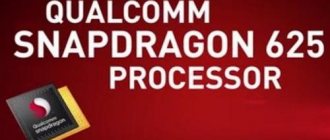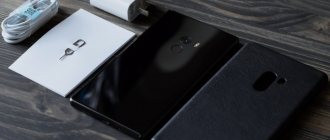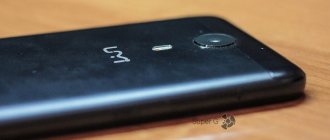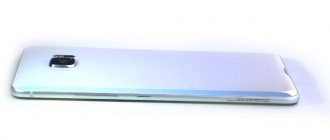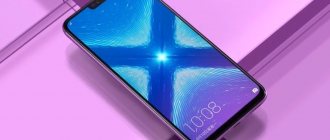The MediaTek Helio P60 chipset today forms the basis for the most powerful mid-range smartphones released in the second half of 2020. Excellent performance, an extensive set of modern features, including an integrated artificial intelligence unit and excellent energy efficiency in resource-intensive applications - all this has made this SoC (System-on-a-Chip) a real bestseller among mobile processors.
To test the Helio P60 chipset, we turned to a new product from BQ Mobile - the flagship model BQ-6200L Aurora.
A little background
At the end of 2020, MediaTek CEO of International Sales Finbarr Moynihan announced that the company was abandoning its flagship line of Helio X processors and refocusing on producing budget, mid-range and sub-flagship solutions.
The release of such processors as Helio P40 and P70 was planned. However, Mediatek made a surprise for the mobile market and at the international exhibition MWC 2020 in Barcelona introduced a new mobile chipset Helio P60 with an artificial intelligence unit.
By mid-summer, this chipset was already used in a number of smartphones from Chinese manufacturers and was successfully tested in practice. In terms of power, the Helio P60 is a budget analogue of the Snapdragon 660 (the 700 series was already introduced at the beginning of 2020), but built using a 12-nm process technology and with better energy efficiency, and also equipped with an AI unit.
MediaTek Helio P60 Specifications and Features
Released at the beginning of 2020, the chipset is a full-fledged and full-fledged competitor to the Snapdragon 660. Unlike it, MediaTek is made in a 12nm process, which has a positive effect on power consumption. It debuted in the Oppo F7 in May last year.
- processor - 8 cores (4 × A73 (2.0 GHz) and energy-efficient 4 × A53 (2.0 GHz));
- video accelerator - Mali-G72 MP3 800 MHz;
- modem - TAS 2.0 smart antenna and Cat.13 LTE (600/150 Mbit/s).
- image processing - Dual ISP (1 camera up to 32 MP, 2 cameras - 20+16 MP), MEMA 3DNR;
- picture - Full HD+, 2400 x 1080;
- artificial intelligence - NPU;
The disadvantages of the Helio P60 processor also include the lack of support for version 5 of Bluetooth (only 4.2).
Why Helio P60 is interesting and useful
As the manufacturer notes, Helio P60 is one of the company’s best chipsets, which includes not only 8 powerful cores, but also an artificial intelligence unit. What can this platform offer the user?
- CPU and GPU performance has increased by 70% compared to previous P-series chipsets. The system can easily cope with resource-intensive games and tasks
— the AI unit works simultaneously with the central and graphic processors, helping to maximize the performance and energy efficiency of the device, which is made possible thanks to the MediaTek NeuroPilot platform. The data processing speed of the AI unit reaches 280 GMAC/s
— high-tech compatibility in cellular networks. MediaTek Helio P60 integrates 4G LTE WorldMode modem, Dual 4G VoLTE and TAS 2.0 smart antenna technology to provide users with uninterrupted connectivity anywhere in the world.
— the chipset supports two cameras with resolutions of up to 20 megapixels and 16 megapixels or one camera with a resolution of 32 megapixels. Thanks to AI technologies, high quality and fast shooting speed are achieved. The neuromorphic block is used for face and scene recognition. High data processing speed ensures recording and playback of HDR images in real time. The user can immediately see what result he will get in the photo.
— high energy efficiency and low heating. The use of 12nm FinFET technology provides unrivaled power efficiency. The system monitors the operation of applications and does not allow them to waste energy, which extends the battery life of the device. CorePilot4.0 technology includes thermal regulation and monitoring of user actions, adapting to it and ensuring maximum performance
— The P60 supports a 20:9 aspect ratio and can work with screens with a notch at the top.
Are there any disadvantages to this chipset? Of course there are, and one of them is a very weak video core. The graphics are represented by the Mali-G72 accelerator with only three cores that can operate at frequencies up to 800 MHz. Yes, this limits the processor’s operating modes in resource-intensive games, automatically setting the settings to average values. But this can also be called a significant plus - after all, on a small smartphone screen in the heat of battle, action is more important than an ultra-detailed picture. The result is less load on the CPU, less heating, and a healthier battery.
Mediatek Helio P60 – which smartphones will it appear in?
It is still difficult to say which brands, and even more difficult to predict which smartphones will feature the new product from Mediatek. However, if we think on a global scale, then third-tier manufacturers will show active interest in the chip. After all, in essence, they will receive the performance level of the Snapdragon 660 (without taking into account graphics), which they can cleverly manipulate, wishful thinking. Naturally, they will rivet flagships (Mediatek does not have anything more modern yet).
At the same time, companies that are not particularly clean can put incredibly high price tags on their gadgets based on the Helio P60. And the argument will be the same comparable power to the Snapdragon 660, along the lines of: “Why should we sell cheap something that is no worse than the 660th dragon?” However, we, of course, do not know what will happen in reality and we only assume all possible scenarios for the development of events.
Source: stevsky.ru
You can close this annoying message by clicking on the cross in the corner A NEW ERA IN PHOTOGRAPHY Meet the Samsung Galaxy S20 | S20+ | S20 Ultra . Shoot in revolutionary 8K resolution and get ultra-sharp, high-quality photos straight from video. Add to this the reliable protection of Samsung Knox, a smart battery, a super powerful processor and plenty of memory for all your files. Open a new chapter in the history of mobile devices.
PALM-SIZED CINEMA SCREEN Samsung's newest smartphones have gone bezel-less with just a tiny hole for the camera, so nothing distracts you from immersing yourself in content on the limitless screen.
The SCREEN with a 120 Hz refresh rate and ultra-fast response makes scrolling incredibly smooth, and the highly sensitive sensor ensures gameplay without the slightest delay. You must see this.
ULTRASONIC FINGERPRINT SCANNER Built into the screen, recognizes your unique fingerprint and provides reliable protection for your smartphone.
NOT AFRAID OF WATER The smartphone can withstand a depth of 1.5 meters for up to 30 minutes, thanks to the IP68 protection level.
ENERGY THAT WILL ENOUGH THE ENTIRE DAY Heavy-duty smart battery up to 5000 mAh (depending on the model) will save you from unnecessary recharging during the day. It also learns how you use your smartphone and saves energy, allowing you to work even longer on a single charge. Ultra-fast charging - charges in minutes, lasts for hours. Fast wireless charging 2.0 - instant power charge. Powershare Wireless Charging - Charge your devices and share with friends.
THINK FAST AND ACT EVEN FASTER Less waiting, more time for important things. Powerful RAM and an advanced processor make the Samsung Galaxy S20 | S20+ | The S20 Ultra is incredibly powerful. It's so smart that it will launch your favorite apps before you think about it.
MADE FOR GAMING Every victory looks even more epic on the limitless screen. The powerful combination of software and hardware delivers ultra-fast response, high performance and smooth, lag-free gaming experience that will surely take you to the top of the rankings.
COME AROUND AGAIN. AGAIN Camera Samsung Galaxy S20 | The S20+' s 64MP resolution captures perfectly clear, detailed images that stay that way even when you zoom in.
ZOOM. SEE EVERYTHING It all starts with the 3‑hybrid optical zoom. Add to it super-resolution zoom capabilities and an intelligent AI camera. Now you won't miss a single detail.
SHOOTING AT NIGHT LIKE DAY The larger image sensor ensures your photos are clear and bright, even in low light. A professional camera will take several pictures at once and combine them into one flawless one, without noise or blur.
Read: Vivo APEX review - the main thing about the concept smartphone
Related articles:
- New Redmi phone with MediaTek Dimensity 1000+ coming soon The first MediaTek Dimensity 1000+ smartphone is the iQOO Z1. But the Taiwanese chipmaker will soon overcome the shortage problem and we will see more smartphones powered by this flagship SoC. And it looks like Redmi will be the next brand […]
- Strongest in the high-end Redmi 10X performance measurement debut Dimensity 820 Dimensity 820, as the latest generation of MediaTek's mid-to-high-end 5G SoC, has received widespread attention since its release. TSMC 7 nm processor, four large 2.6 GHz A76 cores, four 2.0 GHz A55 energy efficiency cores, […]
- Redmi 10X will be the first smartphone with Dimensity 820 5G processor In the afternoon, MediaTek officially launched the Dimensity 820 processor and invited Xiaomi Group Vice President and Redmi Brand General Manager Lu Weibing. On stage, Lu Weibing revealed that the upcoming Redmi 10X will […]
- MediaTek Announces Dimensity 1000+ 5G Chip: First Smartphone Will Be iQOO This afternoon, MediaTek officially launched the flagship Dimensity 1000+ 5G chip. Compared to the original model, it has several improvements such as 144 Hz screen support, as well as improved gaming, display and […]
- MediaTek Dimensity SoC lineup unveiled with dual 5G and Wi-Fi 6 support Yesterday, we received some interesting news about the MediaTek 5G chipset. Today, the company has finally revealed all the tidbits of its most ambitious project to date. New line of SoCs with integrated support […]
- The first cheap 5G smartphones will appear in 2020 thanks to the MediaTek chip MediaTek has developed a SoC compatible with the 5G network. The system-on-chip will rely on the Helio M70 5G modem, a mid-range competitor to Qualcomm's X50 modem. The modem provides download speeds of up to 4.7 Gbps and bandwidth […]
- Lu Weibing: on the use of the new Helio G90T gaming chip on the Redmi Note 8 series Today, Xiaomi Group Vice President, Redmi Brand General Manager Lu Weibing answered user questions on Weibo. Some consumers have asked about the Helio G90T power consumption problem caused by the 12 nm processor […]
- MediaTek launches budget gaming chips Helio G90 and Helio G90T with HyperEngine Game technology Android smartphones come in a lot of variants, but the real options when it comes to phone SoCs are quite limited. The mobile chip market is largely limited to just a few players, and […]
- Is Helio X going to make a comeback? MediaTek confirms launch of new flagship SoC within a year: 7nm, 5G support When we talk about flagship chips in the Android camps, we are talking about Snapdragon 855, Exynos 9820 and Kirin 980. However, it looks like the new flagship SoC will be available at the end this year and will be released by MediaTek. In recent […]
- MediaTek Helio P90 new chip with better AI and faster processor MediaTek today unveiled the Helio P90, its new mid-range SoC based on TSMC's 12nm FinFET manufacturing process. The chip has an eight-core processor, an integrated APU and the best graphics […]
MediatekMediaTek Helio P60Reviews
How this is implemented in the BQ-6200L Aurora
The capabilities of the Helio P60 chipset are clearly demonstrated in our test BQ-6200L Aurora. This is a large 6.2-inch FullHD+ screen with a cutout at the top, and a dual main camera, as well as a 16 MP front camera (both with artificial intelligence function), and support for simultaneous operation of SIM cards in LTE mode, as well as very fast and smooth operation in the interface and applications. About everything in order - below.
This might be interesting:
- Gigaset GS280 smartphone test: mid-range with a good display
Appearance and equipment
Although we are talking about the new chipset, it is worth talking about our impressions of the device itself. The BQ-6200L Aurora looks great - its appearance almost completely replicates the image of flagship models from leading smartphone manufacturers such as Apple and Xiaomi. The large frameless display, covered with protective glass Corning Gorilla Glass 3, is not without a cutout at the top.
The arrangement of the elements is classic: on the bottom there is only a USB Type-C port, on the right there is a conveniently located power button and volume rocker. On the left is a retractable tray for SIM cards (Micro and Nano types), where instead of a second SIM card you can install a MicroSD memory card.
On the back side, in the upper part in the middle of the body, there is a fingerprint scanner, and in the left corner there is a dual camera unit with a flash. The back cover is made of glossy plastic.
It is worth emphasizing that both the screen and the back cover have 2.5D rounded edges and an oleophobic coating. Although fingerprints remain, they are instantly erased with one pass over the surface with a napkin. You won't have to scrub them painfully. This means that your smartphone will always look neat. The only pity is that the manufacturer does not include a silicone case with the smartphone. But, as the test showed, the protection from Xiaomi Mi 8 is excellent.
Important point. The body of the smartphone is made of metal, which affects its weight—about 190 grams. The case is slippery and can easily slip out of your hands. To protect against breaking in the event of a fall or impact, a plastic damping layer, barely noticeable to the touch, is laid between the glass and the body.
Poptel P60 is complete stuffing in “armor”.
Hello, friends. Today I am with another review of a phone from Poptel. The review is of their current top model P60. In this review, I will not throw the phone away, as in previous reviews of phones from this company, since, unfortunately, the site’s audience did not appreciate it anyway. Instead, I will post crash tests from the company, if you are still interested, then continue reading). This smartphone is still the latest in the company’s lineup, but in my opinion, it has some improvements compared to the previous P10. But first, let's look at the technical characteristics of the device.
Technical characteristics of Poptel P60:
● Display: 5.7″, Full HD+ (2160×1080), 18:9, IPS, Corning Gorilla Glass ● Processor: MediaTek Helio P23, eight cores, Mali G71-MP2 graphics ● RAM: 6 GB, LPDDR4 ● Built-in storage: 128 GB, microSD support up to 128 GB ● Main camera: 16+5 MP, dedicated shooting button ● Front camera: 8 MP ● Battery: 5000 mAh, fast charging 5V/2A, wireless charging ● Security: fingerprint scanner, face recognition ● SIM cards: two, nano format, support 4G LTE ● Wireless interfaces: Wi-Fi 802.11n, Bluetooth 4.0, NFC ● OS: Android 8.1 Oreo with add-on from the manufacturer ● Dimensions: 167, 2 x 78.3 x 13.8 mm ● Weight: 248 grams ● Colors: red, green and orange
The phone has grown slightly in display diagonal and screen resolution, the manufacturer has also added RAM and the built-in storage has grown to 128 GB. But the processor remained the same as in P10, the same Helio P23. We will see further what the test results will be.
This phone comes in a black box, like the previous model, only the inscription is different.
Inside we see the phone itself and its accessories on a cradle, arranged in separate boxes.
Inside the largest box there is some waste paper, brief instructions and a warranty card, there is also a protective glass and napkins for sticking it on, and a mediator.
In the next box we have a charging cable, a regular one, not an extended microUSB, which is already a big progress, since you don’t have to look for a special cable if something happens. And plus they included an audio adapter with an extended 3.5 mini jack connector, thanks for that too, you won’t have to look for it yourself.
The last box contains a 5V/2A charger. Although for some reason in the description it is written about fast charging, or it was meant that when charging it takes a large current and charges faster, we will check this later.
Let's actually move on to the phone. This model looks like a typical representative of the family of rugged phones; there are chopped corners, all sorts of protrusions and bulges, but everything in moderation. And despite the diagonal of 5.7 inches, the phone does not look very monstrous. Although to be honest, I prefer the design of the P10 model. This model is available in several color options, mine has red decorative elements, and others have orange and green ones.
The entire front part is occupied by the screen, the buttons in this model, and I see that most of these phones are on-screen. The microphone hole is visible at the bottom.
On top there is a camera window, a light sensor and even, finally, there is a notification LED, which is what I was missing. Of course, it is not as functional as on Xiaomi, but it glows when charging. There may be third-party applications to control the indicator.
On the back of the phone, on top there are 2 cameras and a flash. A fingerprint scanner is located just below. Below the logo you can see the polyphonic speaker grille. By the way, the sound from the speaker here is better than in the P10, there is no metallic sound.
At the bottom end of the phone there is a microUSB charging connector; it does not have a plug. Completely waterproof is declared.
The headset connector is hidden on top under a plug; here you need to use the included adapter, or the housing of your headphone connector will have to be ground off a little. In general, I like this arrangement of connectors; it’s more convenient than having everything on the bottom or everything on top.
On the left side of the phone there is only a tray for two nano SIM cards, or a SIM card + memory card. Usually I consider this a minus of the phone, but in this case, I consider the built-in 128GB sufficient for the user.
On the right side there are as many as 4 control keys. At the top is the volume rocker, below it is the phone's on/off key. Even lower is a programmable key on which you can call any application, and at the very bottom there is a camera shortcut button; it cannot be reconfigured.
The phone body is made of rubber-like plastic, which absorbs shock well when dropped, tested on the P8 model. There are metal inserts on the sides. In general, the body doesn’t displease me, the only thing I would remove is the carbon fiber insert on the back, it doesn’t look good there at all. Despite its size, the phone fits well in the hand, but working with one hand is of course not entirely convenient; if on the Poptel P10 I could reach almost every edge, this won’t work here.
In this model, the manufacturer decided to deviate from the scheme, fill in clean Android and that’s it. Here we have Android 8.1.0, slightly redesigned in appearance. In particular, it installed its own launcher and added a couple of interesting applications. One of them is called “Privacy System”, it allows you to create a password-protected zone on your phone with photos and files that will not be visible in the general file system. Moreover, the launch icon for this application also disappears from the desktop after setup; you can get there by typing the password in the dialer. In short, the application is useful for paranoids and for those who have something to hide in their phone). There is also an SOS application in which you can set emergency phone numbers; an SMS with the text “I’m in trouble” and your GPS coordinates will also be sent to these phones. Desktop themes have also appeared. Otherwise it's pure Android.
Of course, I ran standard synthetic tests, the results are below. By the way, the phone scored almost the same number of parrots in AnTutu as the previous model, despite the larger screen resolution.
Data about the system and sensors in screenshots. A sufficient number of sensors were also poured in.
The screen on the phone is good, it doesn’t go blind in the sun, and the minimum brightness doesn’t blind your eyes in the dark. Thanks to the good resolution, the picture looks great. It fits well in the hand, but using one hand is no longer comfortable. The touchscreen recognizes 5 touches.
I took some photos with my phone cameras. I must say that they finally installed a more or less good camera in the secure phone, or rather even 2, although I suspect the second one is fake. The main one at 16 megapixels takes photos in a resolution of 4608 * 3456, the front one in a resolution of 8 megapixels 3840 * 2176. The video is in FullHD resolution 30fps. The camera can shoot slow motion, time lapses, there is a so-called pro mode where the settings can be changed manually. Autofocus works quickly, the pictures come out clear, especially in good lighting, I have put the compressed photos below, you can see the original on Google Disk.
Some photos in different lighting conditions
Video file properties.
General Complete name: F:\Obzori\poptel p60\DSC_2736_join_001.mp4 Format: MPEG-4 Format profile: Base Media Codec ID: isom (isom/iso2/avc1/mp41) File size: 83.8 MiB Duration: 30 s 302 ms Overall bit rate: 23.2 Mb/s Writing application: Lavf57.40.101 Video ID: 2 Format: AVC / AVC Format/Info: Advanced Video Codec Format profile: [email protected] / [email protected] Format settings, CABAC: Yes / Yes Format settings, RefFrames: 2 frames / 1 frame Format settings, GOP: M=1, N=15 / M=1, N=15 Codec ID: avc1 Codec ID/Info: Advanced Video Coding Duration: 30 s 302 ms Duration_FirstFrame: - 10 ms Duration_LastFrame: -18 ms Bit rate: 23.1 Mb/s Width: 1,920 pixels Original width: 1,920 pixels / 1,920 pixels Height: 1,080 pixels Original height: 1,080 pixels / 1,080 pixels Display aspect ratio: 16: 9 Frame rate mode: Constant Frame rate: 29.970 (30000/1001) FPS Color space: YUV / YUV Chroma subsampling: 4:2:0 / 4:2:0 Bit depth: 8 bits / 8 bits Scan type: Progressive / Progressive Bits/(Pixel*Frame): 0.371 Stream size: 83.4 MiB (99%) Language: English Color range: Full Transfer characteristics: BT.470 System M Matrix coefficients: BT.601
Audio ID: 1 Format: AAC Format/Info: Advanced Audio Codec Format profile: LC Codec ID: 40 Duration: 30 s 294 ms Bit rate mode: Constant Bit rate: 127 kb/s Channel(s): 2 channels Channel positions: Front: LR Sampling rate: 48.0 kHz Frame rate: 46.875 FPS (1024 SPF) Compression mode: Lossy Stream size: 471 KiB (1%) Language: English Default: Yes Alternate group: 1
GPS and WiFi work stably, I can’t say anything special. Satellites are caught as standard for mtk processors, about 8-10 satellites out of 20 are stable on the street. I did a little tracking of the trip, in principle everything is decent, it leads along the highway, although in some places there is a turn off the side of the road. The sound in the speaker is loud, without a metallic sound like in the P10, I can hear well, no one complained. The NFC module works as in all other models, you can link your card. The fingerprint sensor does not raise any special questions, it works, sometimes it does not detect the finger, the unlocking speed is within a second.
Now let's move on to the battery. There is a 5000mAh non-removable battery installed here. At start it takes 1.9A, the white tester filled it with 5152mA. During the charging process, the current gradually decreased. I made a small sign below. The battery discharge took almost 15 hours, the discharge was smooth without failures.
That is, a full charge took 4.5 hours.
Additionally, there is OTG support, it works fine, but only with FAT32 flash drives, it sees NTFS, but offers to format it. Another plus is that the phone can be used as a power bank; it charges the previous P10 normally. Also, as a bonus, there is wireless charging, but my charger that I ordered is lost somewhere and I personally cannot check this feature, but on the Internet they write that it works.
The charging connector is not protected by an elastic band, as I already said, it does not allow water to pass through, at least for now).
Overall, in my opinion, it turned out to be a rather interesting phone, of course, if the price tag is reduced to 200 dollars). I won’t describe the pros and cons of this phone, everyone will still have their own opinion on this matter. I will say that of all three phones from the company, I liked this one the most, not in appearance, but in terms of its contents. And this phone has its own buyer, and even custom ones have already appeared on 4pda. Thank you to everyone who mastered it and, as always, thank you for your adequate comments. Since I decided not to do a full crash test, I’m still doing it wrong), I’m providing a link to a video from the manufacturer.
Z.Y. Whoever has a coupon for $20 from $200, the price becomes interesting.
Update: noname wireless charging is working.
Test of strength.
Video version of the review.
The product was provided for writing a review by the store. The review was published in accordance with clause 18 of the Site Rules.
What did you save on?
Although the BQ-6200L Aurora is positioned by the manufacturer as a flagship, it is very inexpensive - about 16,000 rubles. Therefore, of course, one should expect gaps in its equipment. For example, there was no way to place an LED notification and charge indicator above the screen. Also, at the top we did not see a second microphone to cut out background noise during a call. Perhaps it still exists somewhere, because... During calls, we noted high sound quality without interference.
Alas, this model does not have an NFC module. We also note the not very large capacity of the built-in battery at 3000 mAh. But, as our tests have shown, thanks to the competent operation of the P60 chipset, with a light load in everyday tasks it will last for more than 3 days without recharging.
Performance
The basis of MediaTek Helio P60 is an eight-core 64-bit computing processor assembled using the big.LITTLE architecture. It consists of 2 types of cores, Cortex-A53 and Cortex-A73, the maximum frequency is the same for all - 2 GHz. Heterogeneous multiprocessing is supported - that is, all 8 cores can simultaneously work on the same task (now all chips with big.LITTLE have this, but the very first ones did not have this, which led to endless disputes about whether the Galaxy S4 is eight-core ). The processor is manufactured using a 12nm process technology. In general, on paper everything is not bad at all, let's look at the benchmark that evaluates computing power - Geekbench.
Everything is confirmed: there really is a lot of computing power. The gadget performs at the level of Xiaomi Mi Note 3, based on the Snapdragon 660 chip (it has results of about 1600/5700 in the Geekbench browser). But what about the graphical features? Still, games remain among the few for which the performance of basic chips is absolutely not enough. And MediaTek continues to neglect this component. A three-core Mali-G72 video accelerator with a maximum frequency of 800 MHz is soldered next to the excellent CPU. This is, of course, some progress compared to Helio P20, where there were only two cores, but it is still very funny. We look at the graphic benchmarks, the old GFXBench and the very fresh Basemark GPU (released in mid-June).
See also: LG has patented an unusual case for a smartphone
In the Basemark GPU online results table, the device ranks 3rd at the time of writing this text. From the end. On the one hand, it was even able to slightly overtake the Huawei Mate 10 Pro. On the other hand, it lags behind Xiaomi Redmi Note 3 and Samsung Galaxy J3 Pro. The GFXBench online table has not been updated since February of this year, but comparable results in the benchmark were shown by gadgets on the Snapdragon 808 (that is, the flagship models from the year before last).
OPPO F7, led by MediaTek Helio P60, copes well with both simple toys (Moto Rider, Last Day on Earth on ultra, Air Attack 2) and some quite demanding ones. Unkillеd and Dead Trigger 2 run well at maximum settings. The second one, however, recommends setting the graphics settings to minimum, and it’s scary that even at medium settings it will lag fiercely, but that’s just scary. But with other games the situation is a little worse. “Tanks” are no better than average, like Into the Dead 2, you can play SuperTuxKart at a maximum of “two” (on a seven-point scale). In Injustice 2 you can't customize the graphics at all, and the default ones are very bad. Things are really bad with Asphalt Extreme, which lags even at medium settings with MDPI and even with “OPPO game acceleration”, only turning into something more pleasant at minimum settings.
Seeing such a sad situation, I began to think: how did OPPO allow the Helio P60 to appear not only in the international budget phone F7, but also in the key model for the Chinese market - R15? In China, by the way, there is now a boom in mobile gaming, which is leading to the appearance of “gaming mobile gadgets” on the market. We thought and thought, and decided to test PUBG, the publisher of which for Android is Tencent, one of the culprits of the above-mentioned boom in mobile gaming. When opened, “OPPO Game Acceleration” immediately launched, which also supports two Asphalts (8 and Extreme). Well, it sped up quite well - at high settings (3 settings out of 5) the game runs quite well and with anti-aliasing.
Helio P60 performance test
In almost all benchmarks, this chipset demonstrated good performance in the BQ-6200L Aurora smartphone, which is not inferior to mid-segment products from leading smartphone manufacturers. Experts note that this processor was created as a strong competitor to the Qualcomm Snapdragon 660 processor, installed in a number of popular models, including Xiaomi Mi Note 3, Vivo X20 and many others.
We tested the chip in AnTuTu, Geekbench, GFXBench and Basemark GPU. The result was at the level of very recent flagships based on Snapdragon 808 and even 835.
For example, in AnTuTu the chipset scored about 140,000 points , which is almost equal to the result of the Vivo X21 (also 140,000 points), built on the Snapdragon 660. In Geekbench, the single-core test result was 1515 points (at the level of the Samsung Galaxy S6 on Snapdragon 820), and in multi-core - 5820 (just below the Samsung Galaxy S8 on Snapdragon 835). In Basemark GPU, our BQ-6200L Aurora test unit earned a whopping 947 points , which is decently higher than the OPPO F7 (670 points), also built on the MediaTek Helio P60.
Testing SoC MediaTek Helio P60 (MT6771): opposition player in the mid-segment
Table of contents
- Introduction
- Specifications
- CPU
- CPU in practice
- GPU
- RAM speed
- Energy efficiency (beta)
- Conclusion
Whenever possible, the laboratory publishes separate articles devoted to single-chip systems (SoCs). And since new products in this field come out so often that it is physically impossible to test them all, then, as a rule, flagship SoCs are studied in the materials, because it is in them that the most interesting and new technologies appear. But it is obvious that the bulk of sales are in models of the junior and middle segments, so the new test is intended to clarify the situation in the mass sector.
We've already tested a range of Qualcomm SoCs and one Samsung chip. To complete the picture, this time we will talk about a single-chip system produced by MediaTek.
Let me remind you that the last time we came across a mid-segment solution was the Qualcomm Snapdragon 660, which, although it plays in the same segment, is higher in class and it is incorrect to compare the Helio P60 with it. The closest to the latest is the Snapdragon 636, but we don’t have a database of its results (except for those given in the ASUS ZenFone 5 ZE620KL review), so it won’t be possible to make a comparison. However, it is unlikely to be needed.
To review the SoC MediaTek Helio P60, we will use the OPPO F7, well known to readers of the site, in the 4/64 GB version. A small caveat needs to be made here. The fact is that, unlike flagship and/or simply expensive smartphones, OPPO F7 does not have a heat dissipation system or a metal frame. The device is completely plastic, which from the point of view of heat distribution is even worse than a “glass and metal sandwich”, so in our test the Helio P60 will be subjected to difficult conditions.
announcements and advertising
2080 Super Gigabyte Gaming OC for 60 rubles.
Compeo.ru - the right comp store without any tricks
RTX 2060 becomes cheaper before the arrival of 3xxx
Ryzen 4000
series included in computers already in Citylink
The price of MSI RTX 2070 has collapsed after the announcement of RTX 3xxx
Core i9 10 series is half the price of the same 9 series
The price of memory has been halved in Regard - it’s more expensive everywhere
We'll start by listing the technical characteristics.
| Name | MediaTek Helio P60 |
| Number of cores, pcs. | 4 + 4 |
| Architecture | 4 x Cortex-A73 + 4 x Cortex-A53 |
| CPU core frequency | 4 x 2.0 (1.98) GHz + 4 x 2.0 (1.92) GHz |
| Core operation diagram | big.LITTLE |
| Technical process | 12 nm HPM (TSMC) |
| GPU | Mali-G72 MP3 @800 MHz |
| RAM | LPDDR4X |
| Number of RAM channels | 2 |
| RAM operating frequency, MHz | 1800 |
| eMMC/UFS support | 5.1 / 2.1 |
| LTE | Cat.7 (DL) / Cat.13 (UL) |
| Bluetooth | 4.2 |
As with the Snapdragon 660/636, the competing MediaTek solution offers exactly what users in the mid-range segment have been waiting for for a long time: “thick” Cortex-A7x cores coupled with a “thin” process technology. Yes, this is not an advanced 10 nm or 7 nm technical process, but, as is already clear from analogues, the energy efficiency of 12/14 nm is quite enough to avoid throttling “out of the blue.” However, we will check this.
The second nice feature was the LITTLE cluster, in which the Cortex-A53 cores received a relatively high frequency. Well, the cherry on the cake is support for fast LPDDR4X memory at a very high frequency, although it is not clear what bus is used (most likely 2 x 16 bits, there is no official information about this).
The only shortcomings include the lack of support for Bluetooth 5.0 and a traditionally weak GPU, but we’ll see what place it will take among its competitors.
As already mentioned, the Helio P60 offers a very attractive CPU design of four high-performance Cortex-A73 cores, built according to modern 12 nm manufacturing standards. This greatly distinguishes the SoC from what MediaTek had previously.
Even the flagship Helio X30/Helio X25 single-chip systems could only offer two such cores. Alas, I didn’t test the Helio X series SoC, so we won’t be able to compare the new product with them. But given the low popularity of smartphones with ten-core chips, this is not so scary.
As usual, let's start with the banal. In GeekBench 4, the device shows approximately the performance that you would expect from it. This means, at a minimum, the processor does not overheat and works as it should throughout the test.
This result puts it on par with the same Snapdragon 660, which is positioned a step higher. It also leaves behind the flagships of the past, such as the Snapdragon 820, Exynos 7420 or the same Helio X20.
But the most interesting thing is that the new chip is able to resist even the Snapdragon 835 and Kirin 970. Due to the frequency, the Helio P60 is quite a bit inferior under loads in 1-4 threads mode, but as soon as the load is divided into 5-8 threads, it practically does not lose productivity, which cannot be said about others. A peak of ~1400 Mflops on seven threads is an indicator that the scheduler does not always work linearly, but we will return to this later.
The scatter plot of the results also looks interesting. It can be seen that heating begins to take effect after four load flows. But what’s most interesting is that the peak result with seven threads is clearly visible in the average values. This means that if you work on the scheduler, you can improve the performance of the new SoC.
If you compare the spread of results with the Snapdragon 660, you can see that their stability is approximately the same, but the superiority of the Helio P60 in multi-threading is obvious.
But even if we compare the mid-budget Helio P60 with the incomparable flagship Kirin 970, it turns out that having lost in 1-4 stream modes, which is not surprising given the difference in frequency, our hero competes with it in 5-8 stream modes and in some places even surpasses both average and minimum results. Let me remind you that we have a plastic smartphone.
Test in games
Why else do you need super performance in a smartphone?
For games of course! We checked how quickly the Helio P60 chipset performs in the most popular gaming bestsellers. The result exceeded all expectations. Unkilled and Dead Trigger 2 run smoothly at maximum settings , and the chipset also performed well in the game World of Tanks Blitz . At medium graphics settings, you can comfortably play Into the Dead 2 , PUBG and Last Day on Earth .
Sound quality
This device does not have a dedicated DAC and amplifier, but even without them the sound here is quite decent: with deep bass and pleasant high frequencies. But hardcore music lovers shouldn’t expect miracles.
During calls, the speaker demonstrated good clarity, retaining all the shades of the interlocutor's voice. The ringing speaker is loud with good polyphony. There is a reserve of volume, the vibration will be felt both in the coat and in the backpack.
Camera and artificial intelligence
The smartphone has a dual main camera, one of which is 16 megapixels (with a frame ratio of 4:3), and the second is 5 megapixels. There is also a 16 MP front camera. The camera manufacturer is not specified, but all have an f/2.0 aperture. These are not the best lens clarity indicators, however, tests showed very high-quality results that are not inferior to such recognized cameras as Xiaomi Mi 8.
Of course, there is no image stabilizer and there is no ability to shoot video in 4K, but all the pictures we took, including those in dimly lit places, turned out to a high level. When shooting video in Full-HD, the camera displays static objects well, but moving objects are not clear enough.
Additional tools include support for slow-motion video shooting, time lapse, and a manual settings mode. So, the camera in the BQ-6200L Aurora can be safely recommended both for family and tourist photography, as well as for creative individuals.
1 out of 10
You can download examples of photos in original quality from our cloud storage.
To obtain good quality images, the artificial intelligence unit built into the chipset came in handy here. It automatically detects the type of scene, objects in the frame and selects the best shooting settings. The same can be said for the selfie camera. The pictures from it are juicy and detailed even in poor lighting conditions.
Throttling and heating
See also: Google stops selling Pixel 3 and Pixel 3 XL
In the last section there were many screenshots of benchmarks, but without AnTuTu. We correct the misunderstanding, and 6 times at once. At the same time, we are convinced that the conclusions were made correctly: the CPU is powerful, the GPU is not. And we see another important thing: there is almost no throttling. Over six runs, the result dropped by 1%, which is generally within the statistical error. At the same time, no particularly terrible heating occurred either - only up to 44 degrees.
Neither the fifteen-minute AnTuTu stress test nor the long-term GFXBench test revealed any particular throttling. AnTuTu recorded that the cores dropped the frequency, sometimes quite strongly, but it usually quickly returned to normal levels. In addition, one of the quartets (the blue one) generally plowed almost continuously at maximum speed. At the same time, the battery heated up to the same 44 degrees. With GFXBench, everything is completely stable with the exception of one anti-peak - but this notification came to the phone; a one-time decrease in the result has nothing to do with throttling.
On guard of safety
As we have already said, the artificial intelligence unit takes an active part in recognizing images received from smartphone cameras. This was used in identification mode to enter the smartphone interface by scanning the owner’s face. As the test showed, unlocking occurs instantly, just look at the screen. It works even at an angle and when the device is moving. Phenomenal! Tested on other faces and even on photos: there are simply no false positives.
Energy Saving
Another field for active AI activity is the creation of energy-efficient operation of the device. Mediatek CorePilot 4.0 technology perfectly understands where and when it is necessary to turn up the power to full, but also does not allow energy to be wasted. In particular, one of the most resource-intensive processes is the camera. The Helio P60 uses three image processing processors (ISPs) to reduce power consumption from the two cameras by 18%. In games, the chipset provides savings of up to 25%.
In addition, when you unlock your smartphone, a special service automatically unloads unnecessary processes from memory, which is indicated by a pop-up message.
Speaking of battery performance. Our test smartphone, as we have already noted, uses a 3000 mAh battery. The Geekbench benchmark results - 4144 points - demonstrated its superiority over the batteries installed in OnePlus 5 (3300 mAh) and Samsung Galaxy S8 (3000 mAh) .
Our battery charge test showed that you can charge a smartphone from 12 to 100% in 1 hour 45 minutes (according to the smartphone indicator). The tester showed complete completion of the charge and a capacity of 2650 mAh pumped into the battery. If you add 15% of the residual capacity before charging, you will get about 3000 mAh.
In general, the energy conservation technology in this model has shown the ability to work under heavy load for about 10 hours. In normal mode, the smartphone will last about 4 days before charging.
Product summary:
The Helio P60 chipset used in the BQ-6200L Aurora smartphone provides the device with excellent performance, fast response to gestures and touches, and smooth operation in the interface and applications. The artificial intelligence used in the cameras is not in vain and really allows you to get high-quality pictures even in darkened rooms. The security system when unlocking with a face scanner is also impressive, which works reliably and is almost invisible to the user. The only pity is that the manufacturer saved on such useful things as an LED notification and charge indicator, as well as an NFC chip. But this can also be attributed to trifles against the backdrop of owning a smartphone with a beautiful design and a rich set of functions.
Advantages
High performance Modern design Large FullHD+ screen Metal body High-quality dual and front camera Support for memory cards
Flaws
No notification light No NFC Not very long lasting battery

